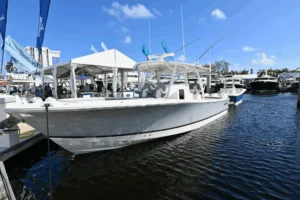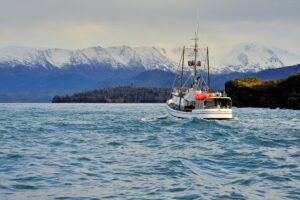Popular Boat Types and What They’re Best Suited For

Boating isn’t one-size-fits-all. The type of boat you choose shapes your entire experience on the water, from the activities you can do to the comfort and convenience you’ll enjoy. A family looking for lazy afternoons on a lake will want something very different than an angler chasing fish offshore or a thrill-seeker carving wakes behind a surf boat.
From center consoles and pontoons to bass boats, cabin cruisers, deck boats, wake/surf boats, jon boats, and personal watercraft, each has its own strengths and tradeoffs. Knowing what each type is designed for makes it easier to match the right boat to your lifestyle and expectations on the water.
Whether you’re shopping for your first boat or considering a change, understanding these differences will help you find the vessel that fits the way you want to spend time on the water.
1. Center Consoles
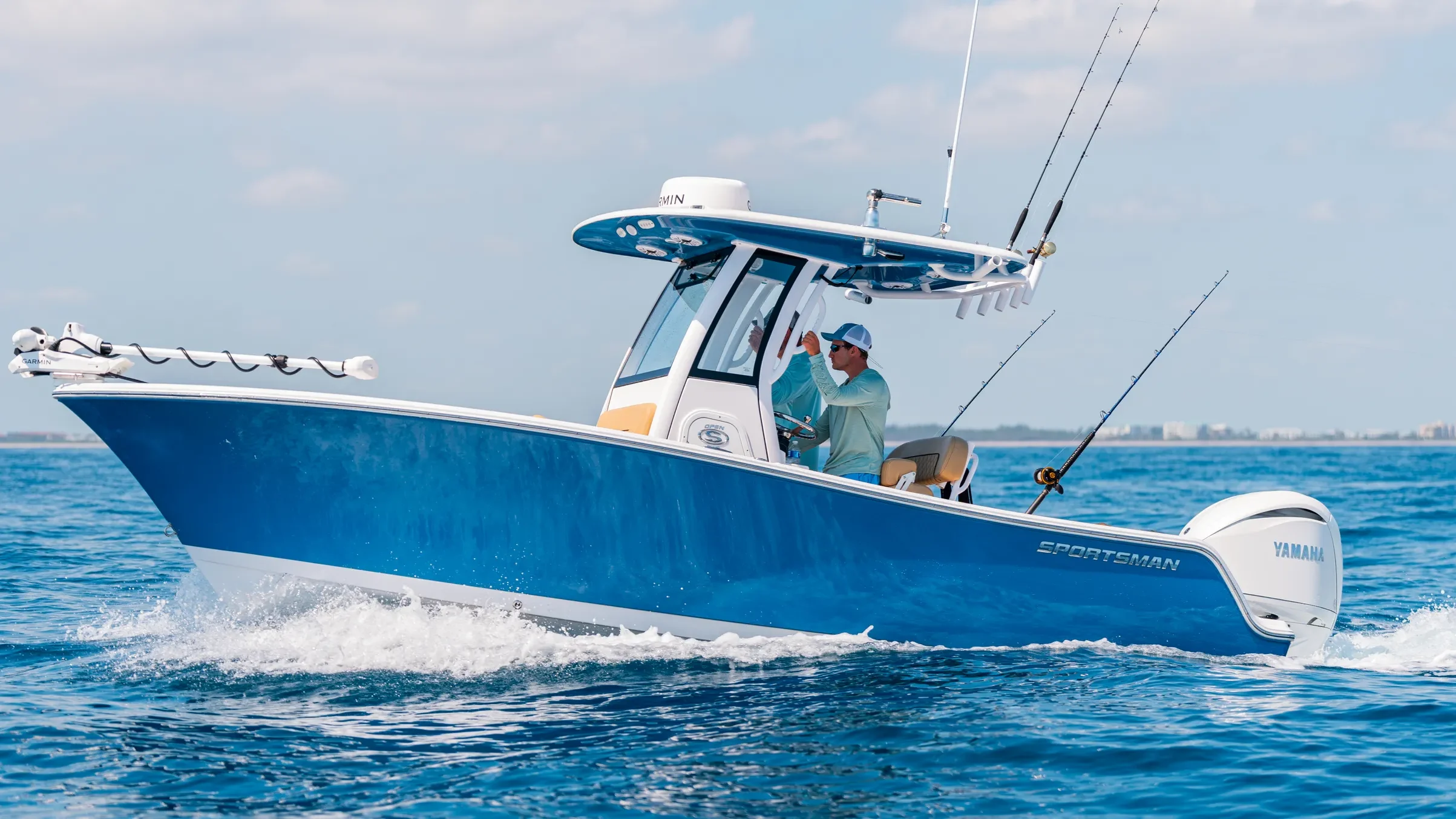
Center consoles are among the most versatile boats on the water, blending serious fishing capability with family-friendly features. Their defining trait is the helm positioned in the middle of the boat, which gives anglers 360-degree walkaround access, perfect for casting lines, fighting fish, or moving gear without obstruction. This layout makes them a favorite for offshore and inshore anglers alike, but they’ve also evolved into do-it-all boats that appeal to families and adventurers.
Sizes range widely, from 18-foot entry-level models ideal for bays and lakes to 40-foot offshore machines equipped with multiple outboards, advanced electronics, and luxury seating. Smaller models are easy to trailer and store, while larger ones can tackle long runs offshore with the power and range to chase pelagics. Many modern center consoles now feature forward seating, convertible sun pads, and even small cabins with heads, making them much more comfortable for family outings than their purely fishing-focused predecessors.
Performance is another strong suit. With their deep-V or modified-V hulls, center consoles handle chop well, providing a stable, confident ride in coastal waters. Multiple rod holders, livewells, fish boxes, and tackle storage come standard on most fishing-focused models, but it’s not uncommon to also see freshwater showers, stereo systems, and shade options that make them just as comfortable for a day of cruising or tubing.
Pricing varies just as widely as their sizes—smaller center consoles can start around $50,000, while large offshore-capable models with triple or quad outboards can run into the hundreds of thousands or even over a million dollars. This range allows buyers to find a center console that matches both their budget and boating style.
Best For: Offshore and inshore fishing, versatile family cruising, watersports
Drawback: Open layout leaves less protection from sun and spray compared to cabin boats
Notable Brands: Sea Hunt, Sportsman, Yellowfin, Everglades, Robalo
2. Pontoons
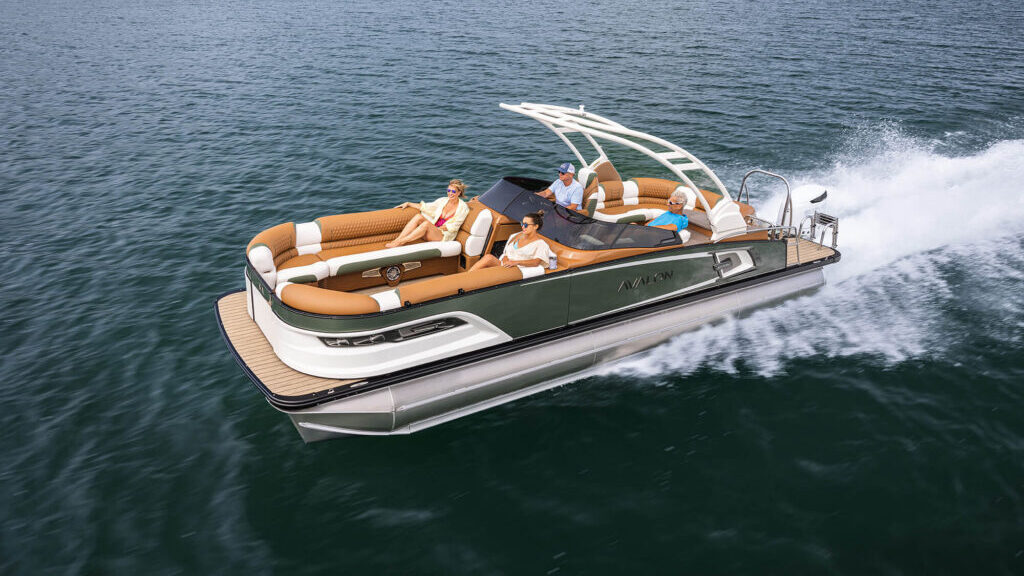
Pontoons are all about comfort, stability, and space, making them one of the most popular choices for families and social boaters. Their flat decks are supported by two or three aluminum tubes (called pontoons), which provide buoyancy and keep the boat steady even with a full load of passengers. This stability is one of the biggest selling points, as it makes pontoons ideal for families with kids, large groups, or anyone who wants a relaxed, secure ride.
Modern pontoons range from 16 to over 30 feet in length, offering a wide range of layouts. Entry-level models are simple, with bench seating and basic features, while high-end pontoons can be outfitted with plush lounges, entertainment systems, grills, and even waterslides. Many are equipped with Bimini tops for shade, and tritoon models (with three tubes instead of two) provide extra buoyancy and performance, allowing for bigger engines and smoother rides in choppier water.
Pontoons typically emphasize leisure over speed, with most cruising comfortably between 15 and 25 mph. However, performance-focused tritoons with larger outboards can push speeds over 40 or even 50 mph, making them capable of watersports like tubing and wakeboarding.
Pricing varies based on size and features. Smaller pontoons can start around $25,000 to $30,000, while luxury models with high-end amenities and big engines can easily exceed $100,000. They’re also relatively easy to maintain compared to larger fiberglass boats, which adds to their appeal for new boaters.
Best For: Relaxed cruising, family outings, entertaining, large groups
Drawback: Less speed and rough-water handling compared to V-hull boats
Notable Brands: Bentley, Bennington, Avalon, Tahoe, Sylvan, Godfrey
3. Bass Boats
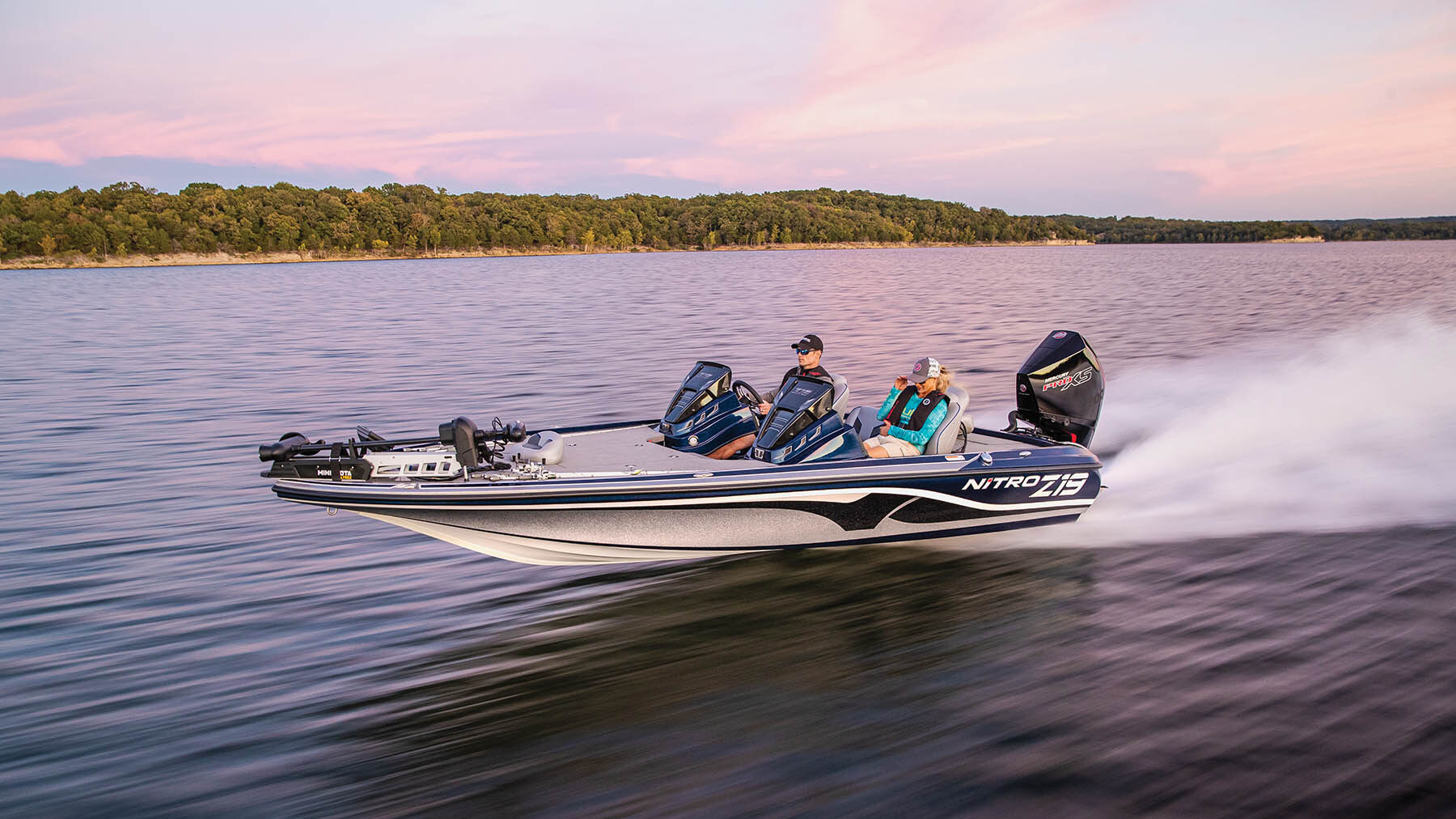
Bass boats are purpose-built for freshwater fishing, especially for targeting bass and other gamefish in lakes and rivers. They’re sleek, low-profile boats designed to maximize fishing efficiency, giving anglers quick access to shallow coves, weed lines, and other hard-to-reach spots.
Most bass boats range from 16 to 22 feet, with seating for two to four people. Their wide casting decks, positioned at both the bow and stern, provide anglers with stable, elevated platforms for casting. Large livewells keep fish healthy during long days on the water, and built-in rod lockers and tackle storage ensure gear stays organized and within easy reach.
Bass boats are also known for their speed. Equipped with high-horsepower outboards, many can reach 50–70 mph, allowing anglers to cover water quickly during tournaments or when moving between fishing spots. Today’s models often come equipped with advanced electronics, including multiple large-screen fish finders, GPS-enabled trolling motors, and live sonar systems that let anglers track fish movement in real time.
The tradeoff is versatility. Bass boats aren’t designed for big water or rough conditions, and they lack the comfort features families often want for cruising or watersports. Prices reflect their specialized focus, with smaller entry-level models starting around $40,000 to $50,000, while high-performance, tournament-ready rigs can exceed $90,000.
Best For: Freshwater fishing, competitive angling, covering water quickly
Drawback: Limited comfort and not suitable for rough or offshore waters
Notable Brands: Ranger, Triton, Skeeter, Phoenix, Nitro, Bass Cat
4. Cabin Cruisers
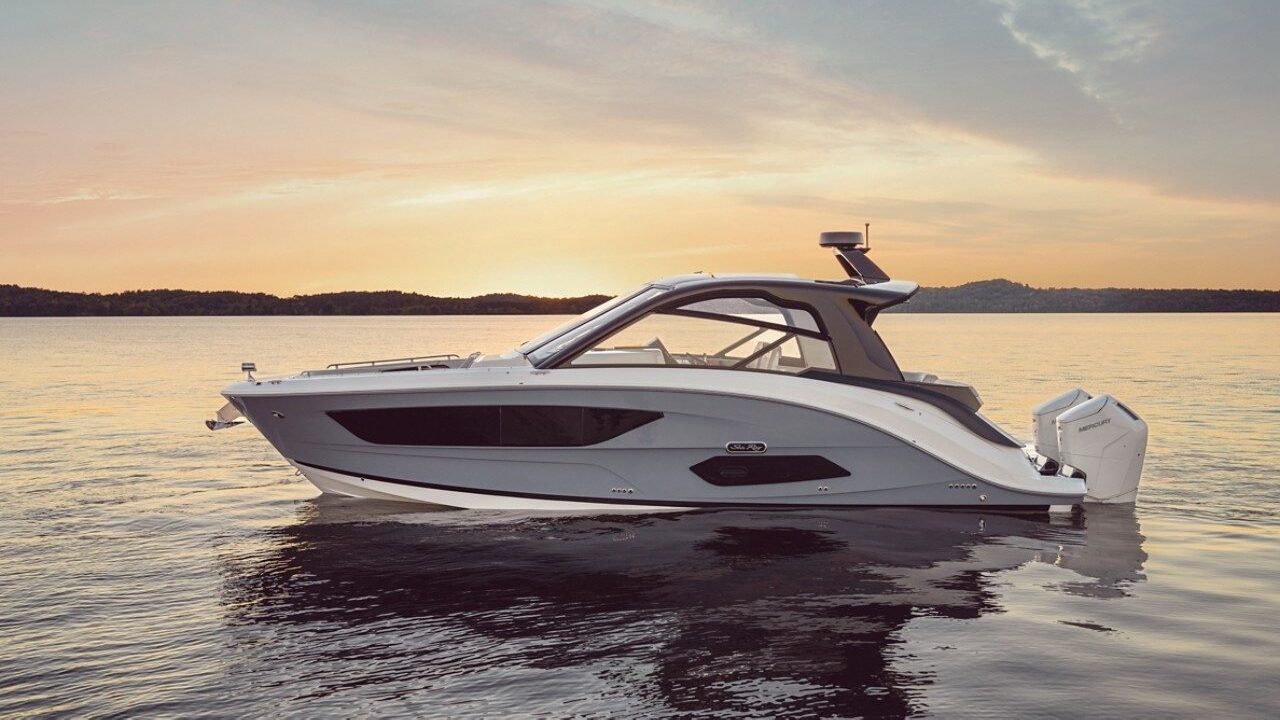
Cabin cruisers are built for comfort, combining the features of a small yacht with the usability of a family powerboat. What sets them apart is the fully enclosed cabin, which usually includes sleeping berths, a galley (small kitchen), and a bathroom. This makes them a natural fit for overnight trips and weekend getaways, giving boaters the ability to stay on the water without sacrificing modern conveniences.
Sizes typically range from 24 to 45 feet, with larger models offering more space below deck and advanced amenities like air conditioning, showers, and entertainment systems. Many are powered by twin engines, giving them the strength for extended coastal cruising or exploring big lakes and rivers.
Owning a cabin cruiser does come with higher costs. They burn more fuel than smaller boats, require more maintenance, and often need a marina slip rather than a trailer. Prices can start around $80,000 for smaller models and climb into the six figures for larger, well-equipped cruisers.
Best For: Overnight trips, family cruising, longer getaways
Drawback: Higher purchase price, maintenance, and fuel costs
Notable Brands: Sea Ray, Regal, Bayliner, Jeanneau, Four Winns
5. Deck Boats
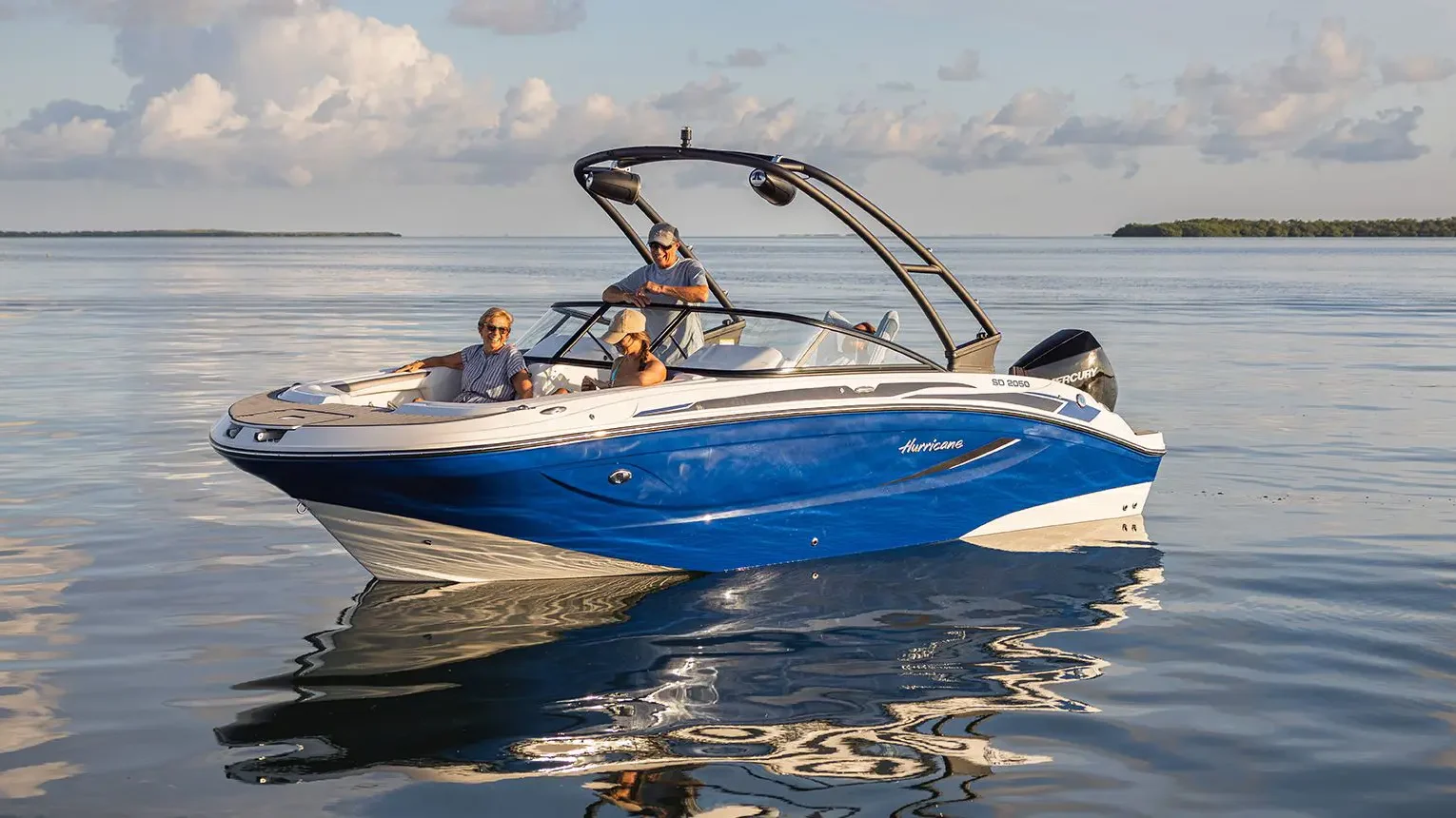
Deck boats are designed for versatility, offering families and groups plenty of space for socializing while still delivering more speed and handling than a pontoon. Their wide, open deck layouts provide ample seating and room for activities like lounging, swimming, or watersports. Think of them as a hybrid between a pontoon’s spaciousness and a center console’s performance.
Most deck boats fall in the 18- to 28-foot range, with seating for 8–12 passengers depending on the model. Their V-shaped hulls allow them to cut through chop better than pontoons, making them suitable for larger lakes and light coastal waters. Many come standard with swim platforms, Bimini tops, and family-friendly layouts, while higher-end versions add upgraded upholstery, stereo systems, and watersports towers.
In terms of cost, deck boats are generally considered mid-range. New models often start around $40,000 and can climb past $80,000 for larger or more feature-rich versions. They’re not as specialized as a fishing boat or a wake/surf boat, but their versatility makes them a solid choice for families who want one boat to cover many activities.
Best For: Water sports, family outings, cruising
Drawback: Less deck space than pontoons; not as specialized for fishing or wake sports
Notable Brands: Hurricane, Chaparral, Bayliner, Starcraft, Regal
6. Wake/Surf Boats
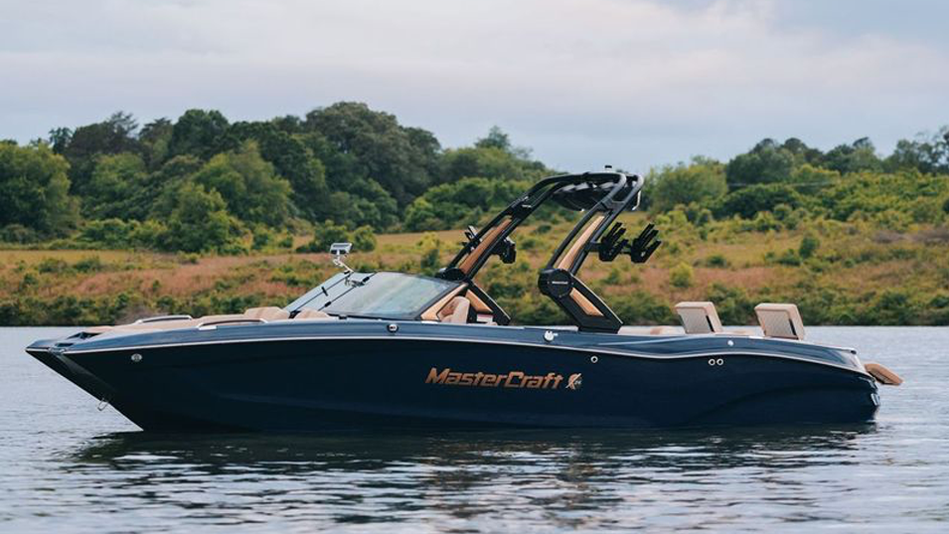
Wake and surf boats are purpose-built for watersports, designed to create large, rideable wakes for wakeboarding and wakesurfing. They use ballast tanks that fill with water to weigh the boat down, combined with wake-shaping devices that adjust the size and contour of the wave. This allows riders to fine-tune the wake to their style, whether they want a tall, steep wave for tricks or a long, rolling surfable wave.
These boats usually range from 20 to 26 feet, with seating for 10–14 passengers. The layouts are designed for gear storage and socializing, with wraparound seating and rear-facing options so passengers can watch the action behind the boat. Built-in racks keep boards organized, while towers often include tow points, speakers, and lights.
Most wake/surf boats are powered by inboard engines, which provide the torque needed to push heavy, ballast-filled boats through the water. This setup is also safer for wakesurfing, since the propeller is tucked under the hull rather than exposed like an outboard.
The biggest tradeoff is cost. New wake boats often start around $80,000 and can easily exceed $150,000 with high-end options. They also burn more fuel when weighted with ballast and require a trailer or marina slip for storage. And while they excel at their specialty, they aren’t designed for offshore runs or general cruising.
Best For: Wakeboarding, wakesurfing, tubing, social lake days
Drawback: High purchase price and fuel costs; limited versatility outside of watersports
Notable Brands: MasterCraft, Malibu, Nautique, Supra, Tige
7. Jon Boats
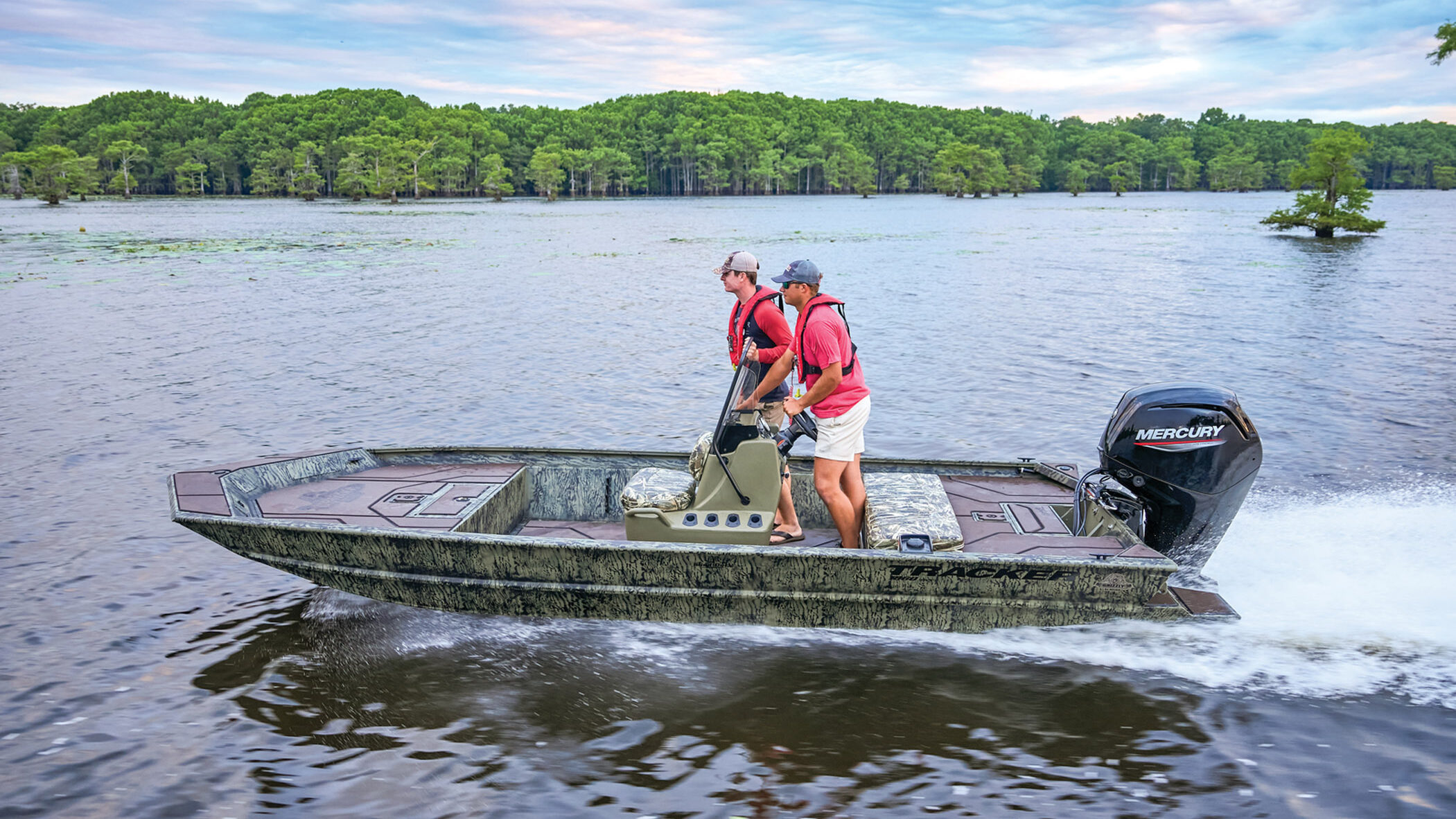
Jon boats are some of the simplest and most practical boats available, valued for their rugged design and affordability. With their flat-bottom hulls and lightweight aluminum construction, they excel in shallow water, making them a go-to choice for freshwater anglers, duck hunters, and anyone who needs a no-frills work boat. Their shallow draft allows them to access backwaters, marshes, and rivers that larger boats can’t reach.
Most Jon boats range from 10 to 20 feet, with widths (or “beam”) that vary depending on stability needs. Smaller versions can be carried in a truck bed or on a lightweight trailer, while larger models can be fitted with consoles, steering systems, and more powerful outboards. They’re typically powered by small outboard motors, though many can also be rowed or pushed with a pole.
One of their biggest advantages is cost. Basic new Jon boats can start as low as $1,500 to $3,000, making them one of the most accessible entry points into boating. Even when outfitted with an outboard and trailer, they remain far more affordable than most other boat types.
The tradeoff is comfort and capability. Jon boats usually have minimal seating, no shade, and limited storage, and their flat bottoms make them less stable in rough or choppy conditions. But their open layouts are easy to customize, and owners often add decks, seats, or gear storage to suit their needs.
Best For: Shallow-water fishing, hunting, utility work, backwater exploration
Drawback: Not suited for rough water; limited comfort and features
Notable Brands: Lowe, Alumacraft, Tracker, G3
8. Personal Water Craft (PWC)
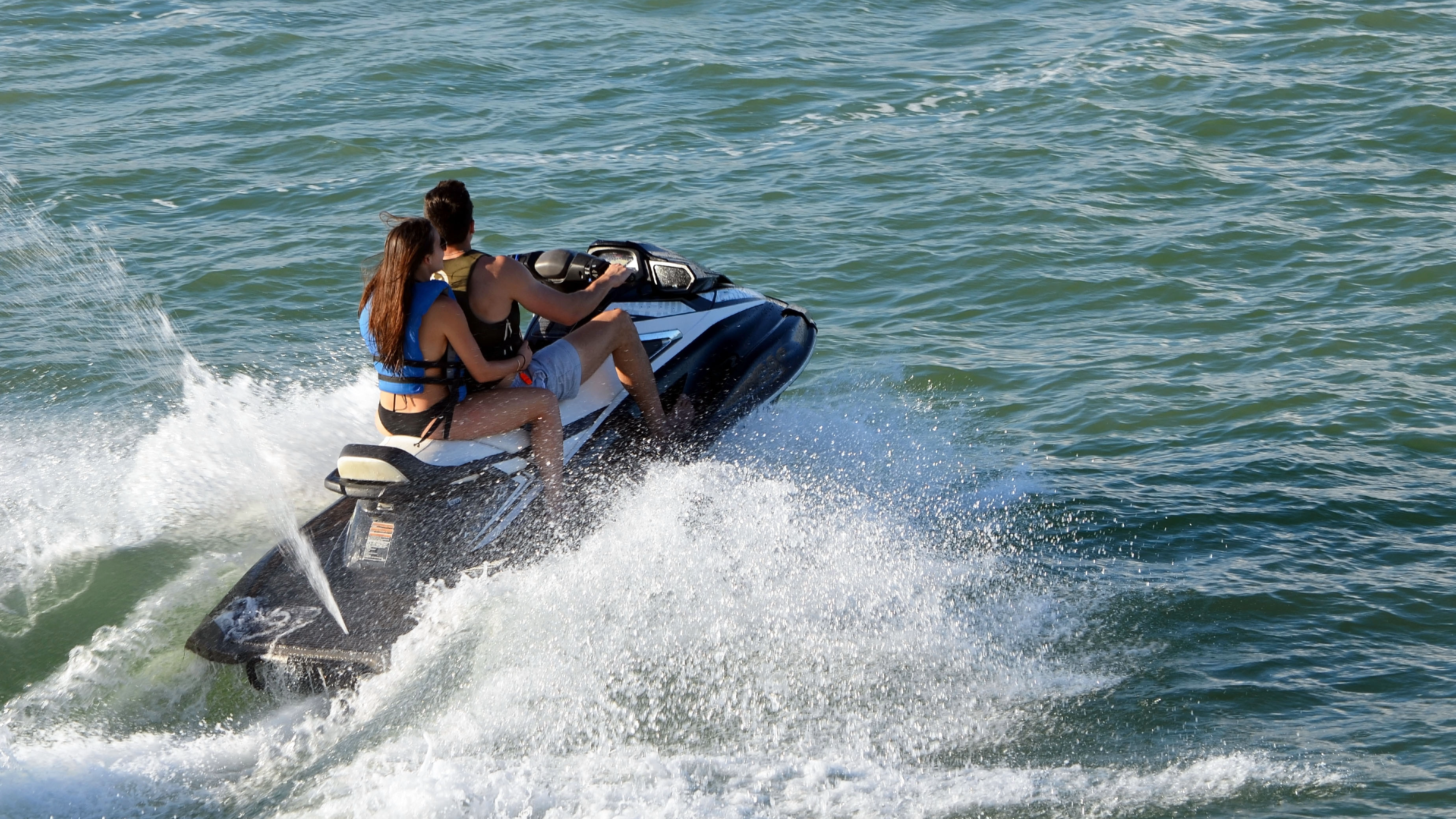
Personal watercraft, or PWCs, are small, agile water vehicles built for speed and thrills. Commonly known by brand names like Jet Ski, WaveRunner, or Sea-Doo, PWCs are designed to carry one to three riders and are often the most affordable and accessible way to get on the water. Their compact size and sharp maneuverability make them ideal for short rides, quick acceleration, and even towing tubes or wakeboarders.
PWCs fall into two main styles: sit-down models, which are more comfortable for longer rides and can carry passengers, and stand-up models, which are smaller and more performance-oriented, requiring more balance and skill to operate. Most range from 8 to 12 feet long and are powered by jet propulsion, which eliminates an exposed propeller and makes them safer for watersports and swimming.
Cost is another reason for their popularity. Entry-level PWCs often start around $7,000 to $10,000, while high-performance models with more horsepower and features can exceed $20,000. Operating costs are also generally lower than larger boats, and their small size makes them easy to tow with most vehicles and store in a standard garage.
The limitations are range and comfort. PWCs don’t offer much storage, shade, or stability in rough waters, and they’re not designed for long-distance cruising. They’re best suited for short, fun runs on lakes, rivers, or nearshore waters rather than extended trips.
Best For: Thrill rides, short trips, towing small inflatables, watersports
Drawback: Limited comfort, range, and storage; not suitable for offshore runs
Notable Brands: Yamaha, Sea Doo, Kawasaki
FAQ
Center consoles are often considered the most versatile. They’re designed for serious fishing but also work well for cruising, watersports, and family outings. With sizes ranging from 18 to over 40 feet, they cover everything from inshore bays to offshore waters.
Pontoons and small deck boats are excellent starter options. They’re stable, easy to handle, and forgiving for new operators. For those focused on fishing, smaller aluminum boats or jon boats provide an affordable, simple entry point.
Pontoons are among the safest family boats thanks to their wide decks and stability, which minimize rocking. For coastal or offshore use, center consoles with higher freeboard (taller sides) offer added security in rougher water.
Both are designed for space and socializing, but pontoons sit on two or three tubes, while deck boats use a V-hull. This gives deck boats better speed and handling in choppier water, while pontoons usually provide more open space and stability at lower speeds.
The answer depends on the water. Bass boats dominate freshwater fishing with large casting decks and shallow drafts. Center consoles are best for saltwater, offering 360-degree fishability and offshore capability. Jon boats are ideal for shallow rivers and marshes.
Wake and surf boats are purpose-built for activities like wakeboarding and wakesurfing. Their ballast systems and inboard engines create ideal wakes. For families who want a mix of tubing, skiing, and cruising, deck boats and some tritoons also work well.
Jon boats and small aluminum fishing boats are typically the cheapest to buy and maintain, with entry-level models starting under $3,000. Personal watercraft (PWCs) are another affordable way to get on the water, usually starting around $7,000 to $10,000.
Pontoons are very stable in calm lakes and rivers, but they’re not designed for heavy chop or offshore conditions. Tritoons, with a third center tube, handle rougher water better, but for true offshore use, a deep-V hull like a center console is safer.
Yes. Many pontoons are outfitted with fishing features like rod holders, livewells, and swivel seats. They provide a stable, roomy platform for casting and moving around. While they lack the speed and specialized equipment of a bass or center console, they work well for casual anglers.
Start with how you plan to use it most. If fishing is your priority, look at bass boats, center consoles, or jon boats. For relaxing with family and friends, pontoons or deck boats are hard to beat. If watersports drive your time on the water, a wake/surf boat is the best fit. Also consider where you’ll use it (lake, river, or ocean), how many people you’ll bring, and your budget for ownership costs.
What’s Right for You?
There’s no single “best” boat, only the boat that best matches how you want to spend time on the water. Center consoles are best for their all-around capability, pontoons for comfort and socializing, bass boats for freshwater fishing, and wake boats for watersports. Cabin cruisers offer overnight comfort, deck boats bridge versatility and speed, jon boats keep things simple and affordable, and PWCs deliver pure thrills.
By weighing your budget, where you’ll use the boat, and the activities that matter most to you, it becomes easier to narrow down the options. Once you understand what each boat type is built to do, the right choice isn’t just clearer, it’s the one that makes every trip on the water more enjoyable.
Follow us on Social Media!
Search
Recent Posts
Experience the excitement of boating in…
Get ready for an exciting lineup…
Experience the 2025 Alaska Boat Shows…








